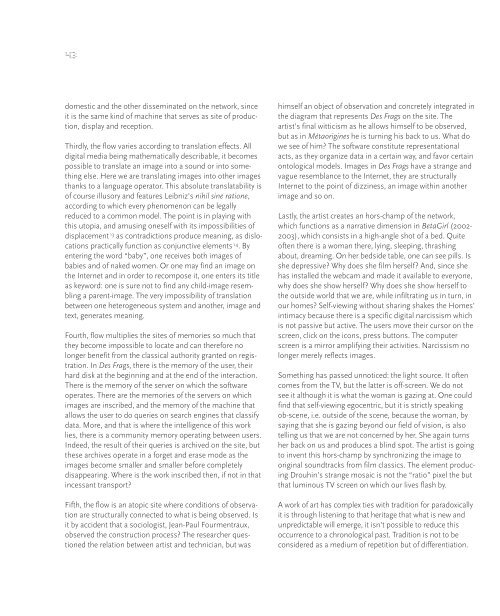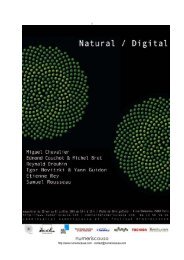Télécharger le pdf de la publication - Reynald Drouhin
Télécharger le pdf de la publication - Reynald Drouhin
Télécharger le pdf de la publication - Reynald Drouhin
You also want an ePaper? Increase the reach of your titles
YUMPU automatically turns print PDFs into web optimized ePapers that Google loves.
43<br />
domestic and the other disseminated on the network, since<br />
it is the same kind of machine that serves as site of production,<br />
disp<strong>la</strong>y and reception.<br />
Thirdly, the flow varies according to trans<strong>la</strong>tion effects. All<br />
digital media being mathematically <strong>de</strong>scribab<strong>le</strong>, it becomes<br />
possib<strong>le</strong> to trans<strong>la</strong>te an image into a sound or into something<br />
else. Here we are trans<strong>la</strong>ting images into other images<br />
thanks to a <strong>la</strong>nguage operator. This absolute trans<strong>la</strong>tability is<br />
of course illusory and features Leibniz’s nihil sine ratione,<br />
according to which every phenomenon can be <strong>le</strong>gally<br />
reduced to a common mo<strong>de</strong>l. The point is in p<strong>la</strong>ying with<br />
this utopia, and amusing oneself with its impossibilities of<br />
disp<strong>la</strong>cement 13 as contradictions produce meaning, as dislocations<br />
practically function as conjunctive e<strong>le</strong>ments 14 . By<br />
entering the word “baby”, one receives both images of<br />
babies and of naked women. Or one may find an image on<br />
the Internet and in or<strong>de</strong>r to recompose it, one enters its tit<strong>le</strong><br />
as keyword: one is sure not to find any child-image resembling<br />
a parent-image. The very impossibility of trans<strong>la</strong>tion<br />
between one heterogeneous system and another, image and<br />
text, generates meaning.<br />
Fourth, flow multiplies the sites of memories so much that<br />
they become impossib<strong>le</strong> to locate and can therefore no<br />
longer benefit from the c<strong>la</strong>ssical authority granted on registration.<br />
In Des Frags, there is the memory of the user, their<br />
hard disk at the beginning and at the end of the interaction.<br />
There is the memory of the server on which the software<br />
operates. There are the memories of the servers on which<br />
images are inscribed, and the memory of the machine that<br />
allows the user to do queries on search engines that c<strong>la</strong>ssify<br />
data. More, and that is where the intelligence of this work<br />
lies, there is a community memory operating between users.<br />
In<strong>de</strong>ed, the result of their queries is archived on the site, but<br />
these archives operate in a forget and erase mo<strong>de</strong> as the<br />
images become smal<strong>le</strong>r and smal<strong>le</strong>r before comp<strong>le</strong>tely<br />
disappearing. Where is the work inscribed then, if not in that<br />
incessant transport?<br />
Fifth, the flow is an atopic site where conditions of observation<br />
are structurally connected to what is being observed. Is<br />
it by acci<strong>de</strong>nt that a sociologist, Jean-Paul Fourmentraux,<br />
observed the construction process? The researcher questioned<br />
the re<strong>la</strong>tion between artist and technician, but was<br />
himself an object of observation and concretely integrated in<br />
the diagram that represents Des Frags on the site. The<br />
artist’s final witticism as he allows himself to be observed,<br />
but as in Métaorigines he is turning his back to us. What do<br />
we see of him? The software constitute representational<br />
acts, as they organize data in a certain way, and favor certain<br />
ontological mo<strong>de</strong>ls. Images in Des Frags have a strange and<br />
vague resemb<strong>la</strong>nce to the Internet, they are structurally<br />
Internet to the point of dizziness, an image within another<br />
image and so on.<br />
Lastly, the artist creates an hors-champ of the network,<br />
which functions as a narrative dimension in BetaGirl (2002-<br />
2003), which consists in a high-ang<strong>le</strong> shot of a bed. Quite<br />
often there is a woman there, lying, s<strong>le</strong>eping, thrashing<br />
about, dreaming. On her bedsi<strong>de</strong> tab<strong>le</strong>, one can see pills. Is<br />
she <strong>de</strong>pressive? Why does she film herself? And, since she<br />
has instal<strong>le</strong>d the webcam and ma<strong>de</strong> it avai<strong>la</strong>b<strong>le</strong> to everyone,<br />
why does she show herself? Why does she show herself to<br />
the outsi<strong>de</strong> world that we are, whi<strong>le</strong> infiltrating us in turn, in<br />
our homes? Self-viewing without sharing shakes the Homes’<br />
intimacy because there is a specific digital narcissism which<br />
is not passive but active. The users move their cursor on the<br />
screen, click on the icons, press buttons. The computer<br />
screen is a mirror amplifying their activities. Narcissism no<br />
longer merely ref<strong>le</strong>cts images.<br />
Something has passed unnoticed: the light source. It often<br />
comes from the TV, but the <strong>la</strong>tter is off-screen. We do not<br />
see it although it is what the woman is gazing at. One could<br />
find that self-viewing egocentric, but it is strictly speaking<br />
ob-scene, i.e. outsi<strong>de</strong> of the scene, because the woman, by<br />
saying that she is gazing beyond our field of vision, is also<br />
telling us that we are not concerned by her. She again turns<br />
her back on us and produces a blind spot. The artist is going<br />
to invent this hors-champ by synchronizing the image to<br />
original soundtracks from film c<strong>la</strong>ssics. The e<strong>le</strong>ment producing<br />
<strong>Drouhin</strong>’s strange mosaic is not the “ratio” pixel the but<br />
that luminous TV screen on which our lives f<strong>la</strong>sh by.<br />
A work of art has comp<strong>le</strong>x ties with tradition for paradoxically<br />
it is through listening to that heritage that what is new and<br />
unpredictab<strong>le</strong> will emerge, it isn’t possib<strong>le</strong> to reduce this<br />
occurrence to a chronological past. Tradition is not to be<br />
consi<strong>de</strong>red as a medium of repetition but of differentiation.






